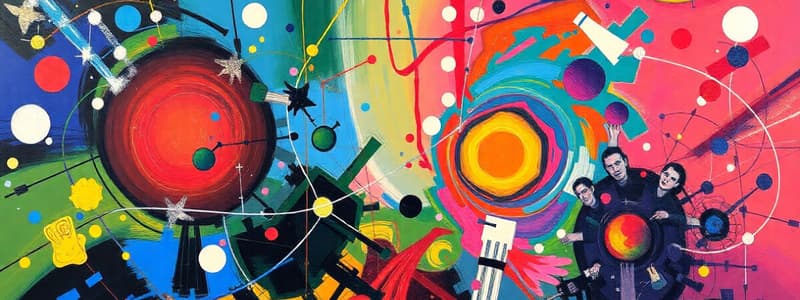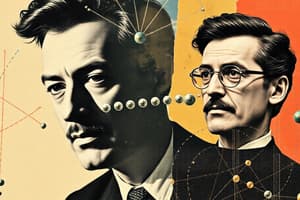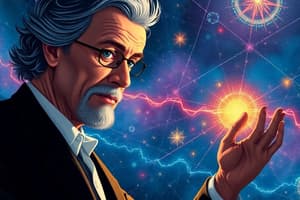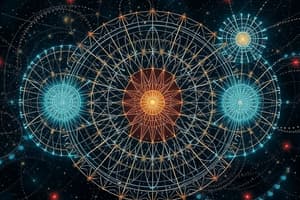Podcast
Questions and Answers
What was Richard Feynman's primary contribution to the field of physics?
What was Richard Feynman's primary contribution to the field of physics?
- Discovery of new subatomic particles
- Advancements in classical mechanics
- Development of nuclear fusion processes
- Research on quantum electrodynamics (QED) (correct)
In which year did Richard Feynman receive the Nobel Prize in Physics?
In which year did Richard Feynman receive the Nobel Prize in Physics?
- 1954
- 1963
- 1965 (correct)
- 1967
During which significant project did Feynman conduct secret bomb research?
During which significant project did Feynman conduct secret bomb research?
- Project Mercury
- The Manhattan Project (correct)
- The Apollo Program
- The Trinity Test
Which educational institution did Feynman attend to obtain his PhD?
Which educational institution did Feynman attend to obtain his PhD?
Which prestigious award did Richard Feynman receive in 1954?
Which prestigious award did Richard Feynman receive in 1954?
Feynman's lectures were compiled into which popular work?
Feynman's lectures were compiled into which popular work?
What was one of Feynman's concerns that motivated his involvement in the Manhattan Project?
What was one of Feynman's concerns that motivated his involvement in the Manhattan Project?
What significant flaw was noted in Feynman's early theoretical work?
What significant flaw was noted in Feynman's early theoretical work?
What is a unique feature of Feynman diagrams in quantum mechanics?
What is a unique feature of Feynman diagrams in quantum mechanics?
Which concept did Murray Gell-Mann theorize about subatomic particles?
Which concept did Murray Gell-Mann theorize about subatomic particles?
Which significant aspect of quantum mechanics did Feynman simplify for broader understanding?
Which significant aspect of quantum mechanics did Feynman simplify for broader understanding?
What was a significant outcome of Gell-Mann's research recognized in 1969?
What was a significant outcome of Gell-Mann's research recognized in 1969?
Which of the following fields did Feynman NOT specifically contribute to?
Which of the following fields did Feynman NOT specifically contribute to?
Flashcards
Quantum Electrodynamics (QED)
Quantum Electrodynamics (QED)
A theoretical framework describing the interaction of charged particles through the exchange of photons.
Feynman's work on QED
Feynman's work on QED
Richard Feynman's most famous work, describing the interactions of charged particles in terms of the exchange of photons.
Manhattan Project
Manhattan Project
The Allied nuclear weapons program where Richard Feynman participated during World War II.
Feynman's secret bomb research
Feynman's secret bomb research
Secret bomb research conducted by Feynman for the Manhattan Project at Los Alamos National Laboratory.
Signup and view all the flashcards
Caltech
Caltech
The California Institute of Technology, where Feynman served as a Professor of Theoretical Physics.
Signup and view all the flashcards
Richard Feynman
Richard Feynman
A renowned physicist who received the 1965 Nobel Prize in Physics for his work on QED.
Signup and view all the flashcards
Feynman Lectures on Physics
Feynman Lectures on Physics
A highly influential textbook based on Richard Feynman's lectures at Caltech.
Signup and view all the flashcards
Albert Einstein Award
Albert Einstein Award
An award recognized by the scientific community for significant contributions in science.
Signup and view all the flashcards
Feynman diagram
Feynman diagram
A visual representation of particle interactions in particle physics, often appearing as lines connecting points, showing the movement of electrons and photons in time and space.
Signup and view all the flashcards
Quark
Quark
A hypothetical building block of matter composed of quarks, which combine to form hadrons like protons and neutrons. These are fundamental particles that contribute to the strong nuclear force.
Signup and view all the flashcards
Standard Model of Particle Physics
Standard Model of Particle Physics
A model that classifies subatomic particles, including fermions and bosons, based on their properties and how they interact. It explains how these elementary particles make up the matter around us.
Signup and view all the flashcards
Backward in Time
Backward in Time
The ability of particles, particularly electrons and photons, to move backwards in time in the context of Feynman diagrams. This concept is crucial for understanding the behavior of particles in quantum mechanics.
Signup and view all the flashcards
Quantum Mechanics
Quantum Mechanics
A subfield of physics that studies the nature of matter and energy at the atomic and subatomic levels. It's known for its strange and counterintuitive concepts, like particles existing in multiple states simultaneously.
Signup and view all the flashcardsStudy Notes
Richard Feynman - Physicist
- Exceptional physicist and inspirational teacher, made complex quantum theory engaging.
- Born in New York to Lithuanian Jewish parents, showed early talent for math and gadgets, did not learn to talk until age 3.
- High school mathematics experiments, refused admission to Columbia due to quota, studied mathematics then physics at MIT.
- 1939: Earned PhD in quantum mechanics from Princeton.
- 1942: Part of Manhattan Project to develop nuclear weapons.
- 1945: Appointed to Cornell University as theoretical physics professor, began significant work on Quantum Electrodynamics (QED).
- QED described interactions of electromagnetism in terms of photons.
- Developed Feynman diagrams for calculation in QED.
- 1950: Professor of theoretical physics at Caltech.
- 1954: Received Albert Einstein Award.
- 1964: Published his Feynman Lectures on Physics books.
- 1965: Awarded Nobel Prize in Physics (with two others), for work on QED.
- Worked at Los Alamos National Laboratory during the Manhattan Project, accommodated in the site's vast trailer park along with many other scientists.
Studying That Suits You
Use AI to generate personalized quizzes and flashcards to suit your learning preferences.





